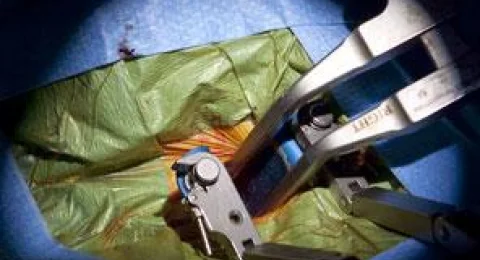The iMAS Procedure: The Masson Keyhole ™
The Masson Keyhole ™
The Masson Keyhole was developed by Dr. Robert Masson, within the iMAS Procedure, in the tradition of the great cranial neurosurgeons that trained and/or inspired him including Dr. Albert Rhoton, Dr. Arthur Day, Dr. Gazi Yasargil, Dr. Taka Fukishima and Dr. Robert Spetzler. It was described first in 2003, during the development of the iMAS Procedure, and is most useful during the sixth, direct decompressive step, of the ten step iMAS Procedure, during an iMAS lumbosacral spine reconstruction procedure.
The Masson Keyhole is defined as the point within the interpedicular space, where the neural elements may be accessed, with the most constant neural anatomy, independent of intervertebral pathology or distortion.
The interpedicular space, is the space in between two vertebra of the lumbosacral spine, from lower pedicle above to upper pedicle below, from the extra-foraminal plane laterally, to the dorsal spinous process medially. Within the interpedicular space lies the traversing nerve root the facet complex, one-half of the thecal sac, the preforamenal segment of the descending nerve root, the foramen, the posterior wall of the superior vertebra, the ligamentum flavum ligamental complex and one-half of the posterior disc.
The Masson Keyhole is defined as the point within the interpedicular space, where the neural elements may be accessed, with the most constant neural anatomy, independent of intervertebral pathology or distortion.
The interpedicular space, is the space in between two vertebra of the lumbosacral spine, from lower pedicle above to upper pedicle below, from the extra-foraminal plane laterally, to the dorsal spinous process medially. Within the interpedicular space lies the traversing nerve root the facet complex, one-half of the thecal sac, the preforamenal segment of the descending nerve root, the foramen, the posterior wall of the superior vertebra, the ligamentum flavum ligamental complex and one-half of the posterior disc.

The Masson Keyhole is immediately inferior and medial to the inferior aspect of the superior pedicle at a 45-degree angle. Microsurgical dissection ventrally, at this point, immediately lateral to the medial limit of the pedicle and below the cortical bone of the inferior aspect of the superior pedicle will allow access to the preforamenal/foraminal junction of the traversing nerve root, independent of 3-dimensional anatomical variation pathologically.
As such, the Masson Keyhole provides a constant and precise starting point for direct decompression of the neural elements, from this safe starting point to more complicated, and distorted compressed neural elements, within the interpedicular space.
As such, the Masson Keyhole provides a constant and precise starting point for direct decompression of the neural elements, from this safe starting point to more complicated, and distorted compressed neural elements, within the interpedicular space.
THE IMAS PROCEDURE ™
The iMAS procedure was originally developed by Dr. Robert Masson in Orlando, FL in 2001. Dr. Masson has now done several thousand iMAS procedures.
The iMAS Procedure is a total procedural solution for minimally invasive lumbosacral spinal decompression, reconstruction and stabilization. Historically, all of the phases of spine surgery were compartmentalized individual solutions done through different products and phases of the case with little if any integration. iMAS differs in that all of the products and sequence of use of products are arranged synergistically as a complete Symphony Solution, maximizing objective and outcome, while reducing dramatically morbidity, complications, infections, length of time in surgery, incision size, blood loss, length of stay and ultimately time away from fitness, performance and life.
In a recent consecutive patient series of 100 one level decompression fusions with pedicle screw, interbody fusion and micro-decompression via a single wound, Dr. Masson averaged 53 minutes in surgery, 72 minutes of anesthesia time, 14 mm length incision, 117 cc of estimated blood loss, average length of stay 1.1 days in the hospital (many being done outpatient).
Dr. Masson, via his iMAS procedure has been credited with having the least invasive micro-reconstruction in the world. Dr.Masson, via his iMAS…and has developed more than 20 iMAS Centers of Excellence worldwide.
The iMAS Procedure is an advanced symphony solution integrating the technologically most sophisticated equipment and techniques. In its pure form, it is an image-guided, advanced microsurgical solution focusing on a specific 3D reconstructive plan designed to maximize the spatial characteristics around the spinal cord and nerve roots, preserving vital musculoskeletal function and attachments, while providing the most structurally sound spine reconstruction available in the world.
When combined with proper fitness and conditioning, prehabilitation, rehabilitation and physical training, even patients participating in rigorous hobbies and jobs are able to return to complete activity.
The procedure itself is not functionally limiting. It is the general physical health, conditioning and rehabilitation fulfillment which defines the future of the spine-injured patient.
Bio mechanical data and functional studies are being performed by the Masson Spine Institute in an ongoing effort to proactively define long-term outcome data for spinal reconstruction. The data is overwhelming that patients who prehab, maintain healthy weight status, avoid substance dependency, both narcotic and otherwise, and seek regular lifestyle maintenance, nutrition and fitness have a 7 to 1 rate of return to normal function after the iMAS Procedure as compared with the group who fails on the above commitments.
The iMAS Procedure is a total procedural solution for minimally invasive lumbosacral spinal decompression, reconstruction and stabilization. Historically, all of the phases of spine surgery were compartmentalized individual solutions done through different products and phases of the case with little if any integration. iMAS differs in that all of the products and sequence of use of products are arranged synergistically as a complete Symphony Solution, maximizing objective and outcome, while reducing dramatically morbidity, complications, infections, length of time in surgery, incision size, blood loss, length of stay and ultimately time away from fitness, performance and life.
In a recent consecutive patient series of 100 one level decompression fusions with pedicle screw, interbody fusion and micro-decompression via a single wound, Dr. Masson averaged 53 minutes in surgery, 72 minutes of anesthesia time, 14 mm length incision, 117 cc of estimated blood loss, average length of stay 1.1 days in the hospital (many being done outpatient).
Dr. Masson, via his iMAS procedure has been credited with having the least invasive micro-reconstruction in the world. Dr.Masson, via his iMAS…and has developed more than 20 iMAS Centers of Excellence worldwide.
The iMAS Procedure is an advanced symphony solution integrating the technologically most sophisticated equipment and techniques. In its pure form, it is an image-guided, advanced microsurgical solution focusing on a specific 3D reconstructive plan designed to maximize the spatial characteristics around the spinal cord and nerve roots, preserving vital musculoskeletal function and attachments, while providing the most structurally sound spine reconstruction available in the world.
When combined with proper fitness and conditioning, prehabilitation, rehabilitation and physical training, even patients participating in rigorous hobbies and jobs are able to return to complete activity.
The procedure itself is not functionally limiting. It is the general physical health, conditioning and rehabilitation fulfillment which defines the future of the spine-injured patient.
Bio mechanical data and functional studies are being performed by the Masson Spine Institute in an ongoing effort to proactively define long-term outcome data for spinal reconstruction. The data is overwhelming that patients who prehab, maintain healthy weight status, avoid substance dependency, both narcotic and otherwise, and seek regular lifestyle maintenance, nutrition and fitness have a 7 to 1 rate of return to normal function after the iMAS Procedure as compared with the group who fails on the above commitments.




